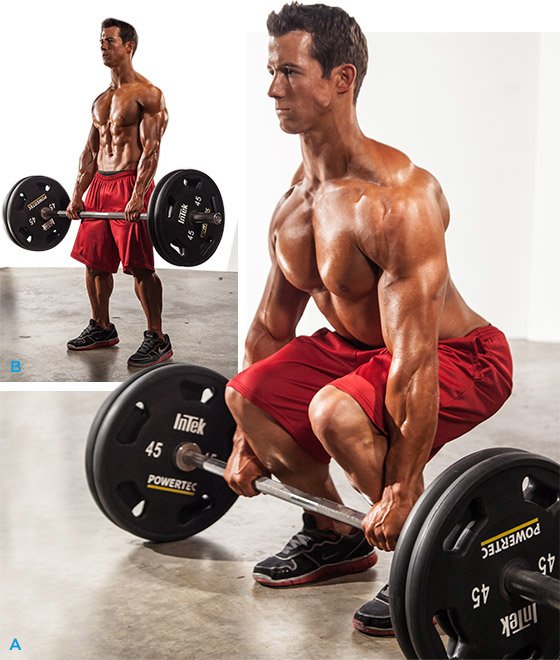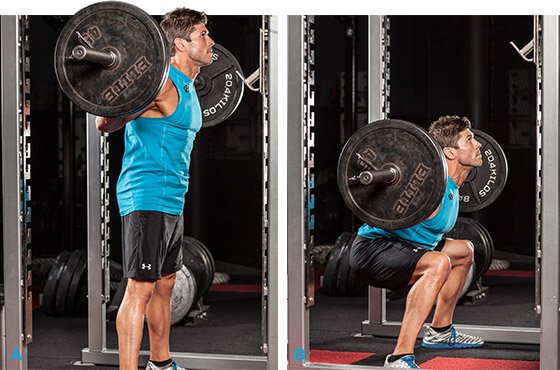Nearly every lifter can squat and deadlift 225 pounds with persistence, proper form, and the right program. Walk the road to two plates!





The barbell is calling your name. You've been going to the gym for a quite a while now, and you're comfortable doing the usual lower body machine exercises. Now you feel like you're ready for a new challenge, and you're sure it should involve barbells. But how, and to what end?
You could go a couple of different ways here. You could tinker around on those thin-handled barbells over by the dumbbell racks, doing your best to perform squats, lunges, and Romanian deadlifts in a crowd of people doing curls and presses.
Or you could step into the squat rack or onto the platform, make the commitment to learn how to handle an Olympic bar and plates, and work toward the goal of a nice, round number.
Don't sell yourself short. Get serious, learn proper form, and make yourself proud in the weight room this year!
WHO IS BARBELL TRAINING FOR?
Lower-body free-weight training is an entirely different beast compared to lower body machine-based exercise. The leg press, knee extension, and leg curl machines have their place, but if you want to develop lower body strength and power, you're going to have to squat and deadlift.
These closed-chain kinetic exercises—meaning your feet are in contact with the floor—challenge your legs, core, and hip stabilizer muscles in a totally unique fashion.
If physique transformation is your goal, they provide a more powerful full-body stimulus than any machine, in half the time. These exercises also have better transference to athletic qualities such as sprinting and jumping.

BARBELL DEADLIFT
You'll hear people brag about big numbers, but ignore them for now. No matter what comes afterward, 225 in the squat or deadlift is a respectable milestone for any non-powerlifter, amateur athlete, or weekend warrior.
A 200-plus deadlift is also a tough but realistic goal for most fit women. I've known many who've already achieved it, and many more who can.
The back squat is a more difficult lift for many women to go heavy, but squatting heavier than bodyweight is still a worthy goal to start, and this program can get you there.
Endurance athletes like distance runners, cyclists, and rowers can also benefit from adding heavy squats and deadlifts to their injury-prevention routine.
Lifting greater than bodyweight improves neuromuscular efficiency to the fast-twitch type-II muscle fibers; and it has been shown in studies to lead to better performance in endurance sports.
Despite the "thin and weak" stereotype, endurance athletes can benefit immensely from more strength—and don't worry, 225 isn't a number that you'll need to get "bulky" to achieve.
So what's the best approach to reach two plates on each side of the barbell? Well, first and foremost, you need to be able to execute each lift with optimal biomechanics. Once you get the form down, just take that light weight you move around, and make it heavier.
THE ESSENTIALS OF THE SQUAT
A number—be it, 225, 425, or 75—means nothing if it's done with bad form: knees caved, torso doubled over, and a back that looks like it's about to break.
I'm only interested in helping you own the number, and that means squatting with your hip crease dipping below your knee crease at the bottom of the squat, which is referred to as an "ass-to-grass" squat.
If you can't squat that deep, well, you're in the company of many, many gym-goers.
But you're not off the hook! Just place a 10-pound plate under each heel. This will create a slight anterior weight shift and make up for tight ankles. Still, drive your knees out and keep most of your weight from your mid-foot to your heel.
There should be a slight lean in your torso, and your lower and upper back should have good alignment without excessively rounding or arching.
Last, your knees should be held outward, with your feet roughly shoulder-width apart and your heels flat on the floor.
Ideally, you would have a barbell on your back in the "high bar" position, resting mainly on your trapezius muscles and the upper ridge of your shoulder blades.

BACK SQUAT
A great tip from the world of powerlifting is to push your knees out as if you were spreading the floor with your feet. This results in greater stability as your hip muscles tighten up to hold your knees outward.
Pull the bar into your traps as if you are trying to break it across your back. This cue will activate your lats, create more torso stability, and prevent you from falling forward.
THE ESSENTIALS OF THE DEADLIFT
The hip hinge is the major movement pattern involved in a conventional deadlift.
Essentially, the hips act like a hinge and flex, while your torso leans forward and your shins stay relatively vertical—that's the difference between a hinge and a squat.
No ass-to-grass here; the hip motion is primarily back-and-forth rather than up-and-down.
As with the squat, however, the spine stays aligned and doesn't round or extend during a deadlift.
But you should feel more tension in your hamstrings than a squat, particularly at the bottom of the movement, where the bar is on the ground.
Also, make sure you perform this movement with soft or slightly bent knees. We're not doing stiff-legged deadlifts here.
To perform a conventional deadlift, step up to the bar with a hip-width stance. Bend your knees and hips, and grab the bar with a double overhand grip to the outside of your shins.
Push your hips back and puff out your chest. Your spine should be straight with your shoulders just in front of the barbell and slightly higher than your hips.

THE SQUAT (LEFT) IS A QUAD-DOMINANT EXERCISE. THE HIP-HINGE (RIGHT) IS THE MAJOR MOVEMENT PATTERN OF A DEADLIFT, IN WHICH THE HIPS ACT LIKE A HINGE AND FLEX, WHILE YOUR TORSO LEANS FORWARD AND YOUR SHINS REMAIN VERTICAL.
Brace your abs and engage your lats. As with the squat, you should feel most of your balance and body weight from mid-foot to heel. With your chin slightly tucked in, stand up with the bar, keeping it close to your body.
Finish with a deliberate hip extension and glute squeeze. Don't lean back excessively; this places unwanted stress to your lumbar spine. Now slide the bar down your thighs as you push your hips backward. Once the bar passes your knees, sit the bar back to the floor. Reset your position and prepare for the next rep.
THE ROAD TO 225
The best way to get stronger and better at a lift is to perform it more frequently throughout the week. This plan will focus on getting your high-bar back squat and conventional deadlift to 225 in a straightforward, systematic way, using three full-body workouts per week.
Here, I'll just illustrate the squat and deadlift routine; feel free to add any upper-body lifts as you see appropriate, as long as they don't detract from the work you do here.
For the first workout, use a weight you can confidently lift for 5 sets of 5 reps, but which still feels somewhat heavy.
If you're successful at completing all reps in each set, add weight in 5-pound increments and attempt to perform all 5 sets of 5 reps the following week.
Keep moving up in this manner until you hit what feels like a limit.
Don't attempt a rep if you suspect you might not make it; just end the set. If you fail and your reps go like this: 5, 5, 4, 3, 3, use the same weight the next week, and attempt all 5 sets of 5 reps again.

DETAILS, DETAILS

MIXED GRIP OR OVERHAND? SUMO OR CONVENTIONAL? STRAPS, BELTS, OR NOTHING AT ALL? FOCUS ON LEARNING THE SQUAT AND DEADLIFT MOVEMENTS FIRST. YOU MAY FIND LATER THAT A MIXED GRIP OR A SUMO STANCE IS MORE COMFORTABLE AT HEAVIER WEIGHTS.
For Wednesday's workout, use a submaximal weight (roughly 60 percent of the weight used on Monday) and perform speed deadlifts.
The execution of the deadlift is the same; however, the bar is to be lifted as fast as possible with correct form.
For the jump squat, execute the squat as written above, but explode from the bottom position and jump off the ground. Land lightly and prepare for the next rep.
Last, for Friday's workout, start with a light weight and perform 5 reps. Add a little bit of weight, and after your rest, perform another 5 reps.
Keep adding weight over the next 5-6 sets to reach the maximum weight you can perform 5 reps with, which is called your 5-rep max (5RM). In week two, work up to a max set of 3 reps. In week three, work up to a max set of 1 rep.



No comments:
Post a Comment